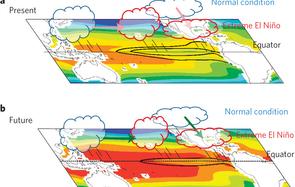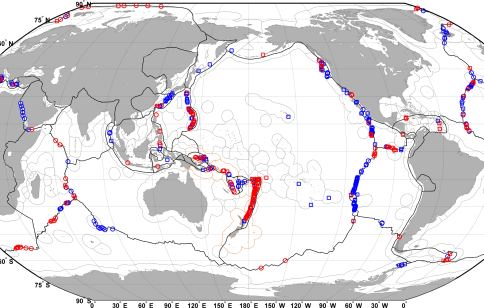Feature Publication Archive

Present (a) and future (b) convection zones in the western Pacific.
Cai, W., S. Borlace, M. Lengaigne, P. van Rensch, M. Collins, G. Vecchi, A. Timmermann, A. Santoso, M.J. McPhaden, L. Wu, M.H. England, G. Wang, E. Guilyardi, and F.-F. Jin (2014): Increasing frequency of extreme El Niño events due to greenhouse warming. Nature Climate Change, 4, doi: 10.1038/nclimate2100, 111-116.
In a paper recently published in Nature Climate Change, a group of climate scientists, including Dr. Michael McPhaden of PMEL, used 20 climate models to assess possible changes in El Niño behavior in response to greenhouse gas forcing over the next 100 years. They found a consistent pattern across most models for the frequency of intense El Niños to double in the 21st century, with the likelihood of extreme events occurring roughly once every 10 years instead of once every 20. Intense El Niños, like those in 1982-83 and 1997-98, have dramatic worldwide impacts, increasing... more »

Locations of all known active vent fields, distinguishing confirmed (square) and inferred (circle) and whether discovered and/or confirmed prior to (blue) or after (red) year 2000.
Beaulieu, S.E., E.T. Baker, C.R. German, and A. Maffei (2013): An authoritative global database for active submarine hydrothermal vent fields. Geochem. Geophys. Geosyst., 14(11), doi:10.1002/2013GC004998, 4892-4905.
The InterRidge Vents Database is available online as the authoritative reference for locations of active submarine hydrothermal vent fields. This paper describes the revision of the database to an open source content management system and provides a meta-analysis of the global distribution of known active vent fields. The number of known active vent fields has almost doubled in the past decade (521 as of year 2009), with about half visually confirmed and others inferred active from physical and chemical clues. Although previously known mainly from mid-ocean ridges (MORs), active vent... more »
Hermann, A.J., G.A. Gibson, N.A. Bond, E.N. Curchitser, K. Hedstrom, W. Cheng, M. Wang, P.J. Stabeno, L. Eisner, and K.D. Cieciel (2013): A multivariate analysis of observed and modeled biophysical variability on the Bering Sea shelf: Multidecadal hindcasts (1970-2009) and forecasts (2010-2040). Deep-Sea Res. II, 94, doi:10.1016/j.dsr2.2013.04.007, 121-139.
It is a safe bet that the future will include a warmer Bering Sea. But it is uncertain exactly how climate change will be manifested, and in particular, how fast it will warm in summer versus winter, and in the north versus the south. Nevertheless, these details in the climate forcing are key in terms of their impacts on plankton distributions and types, and ultimately the entire marine ecosystem. The formidable problem of how climate change is liable to impact lower-trophic levels, i.e., the base of the food web, was tackled under the auspices of the Bering Sea Project using novel methods... more »
Kessler, W.S., and S. Cravatte (2013): ENSO and short-term variability of the South Equatorial Current entering the Coral Sea. J. Phys. Oceanogr., 43(5), doi:10.1175/JPO-D-12-0113.1, 956–969.
The South Equatorial Current (SEC) is the westward limb of the South Pacific subtropical gyre, carrying transport and water properties accumulated over a decade or more circulating around the gyre. Arriving at the coast of Australia, the current splits, turning north or south. The northward flowing part is of great interest for the tropical climate because it represents a principal means for the equator to feel the effect of the extratropics, and its effects can be magnified since equatorial air-sea interaction is very sensitive to small anomalies. Much work over the past two decades has... more »
Hermann, A.J., G.A. Gibson, N.A. Bond, E.N. Curchitser, K. Hedstrom, W. Cheng, M. Wang, P.J. Stabeno, L. Eisner, and K.D. Cieciel (2013): A multivariate analysis of observed and modeled biophysical variability on the Bering Sea shelf: Multidecadal hindcasts (1970–2009) and forecasts (2010–2040).
It is a safe bet that the future will include a warmer Bering Sea. But it is uncertain exactly how climate change will be manifested, and in particular, how fast it will warm in summer versus winter, and in the north versus the south. Nevertheless, these details in the climate forcing are key in terms of their impacts on plankton distributions and types, and ultimately the entire marine ecosystem. The formidable problem of how climate change is liable to impact lower-trophic levels, i.e., the base of the food web, was tackled under the auspices of the Bering Sea Project using... more »


